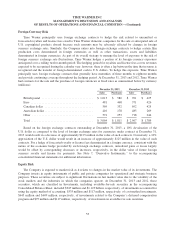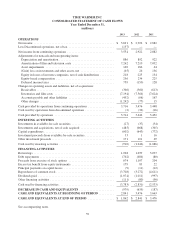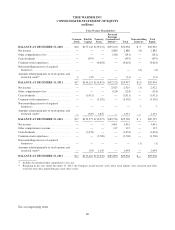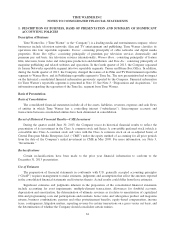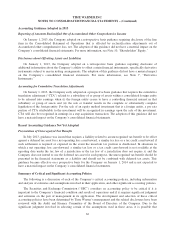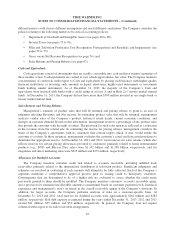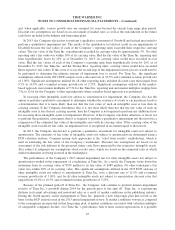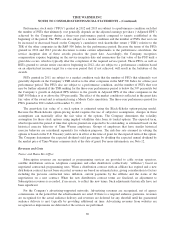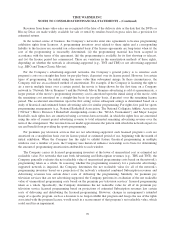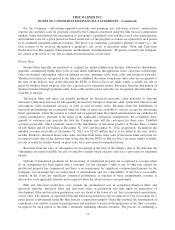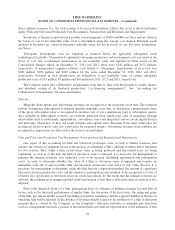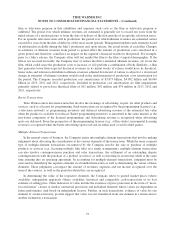Time Magazine 2013 Annual Report Download - page 79
Download and view the complete annual report
Please find page 79 of the 2013 Time Magazine annual report below. You can navigate through the pages in the report by either clicking on the pages listed below, or by using the keyword search tool below to find specific information within the annual report.TIME WARNER INC.
NOTES TO CONSOLIDATED FINANCIAL STATEMENTS – (Continued)
different parties could choose different assumptions and reach different conclusions. The Company considers the
policies relating to the following matters to be critical accounting policies:
• Impairment of Goodwill and Intangible Assets (see pages 66 to 68);
• Income Taxes (see pages 75 to 76);
• Film and Television Production Cost Recognition, Participations and Residuals and Impairments (see
pages 72 to 73);
• Gross versus Net Revenue Recognition (see page 74); and
• Sales Returns and Pricing Rebates (see page 63).
Cash and Equivalents
Cash equivalents consist of investments that are readily convertible into cash and have original maturities of
three months or less. Cash equivalents are carried at cost, which approximates fair value. The Company monitors
concentrations of credit risk with respect to Cash and equivalents by placing such balances with higher quality
financial institutions or investing such amounts in liquid, short-term, highly-rated instruments or investment
funds holding similar instruments. As of December 31, 2013, the majority of the Company’s Cash and
equivalents were invested with banks with a credit rating of at least A and in Rule 2a-7 money market mutual
funds. At December 31, 2013, the Company did not have more than $500 million invested in any single bank or
money market mutual fund.
Sales Returns and Pricing Rebates
Management’s estimate of product sales that will be returned and pricing rebates to grant is an area of
judgment affecting Revenues and Net income. In estimating product sales that will be returned, management
analyzes vendor sales of the Company’s product, historical return trends, current economic conditions, and
changes in customer demand. Based on this information, management reserves a percentage of any product sales
that provide the customer with the right of return. The provision for such sales returns is reflected as a reduction
in the revenues from the related sale. In estimating the reserve for pricing rebates, management considers the
terms of the Company’s agreements with its customers that contain targets which, if met, would entitle the
customer to a rebate. In those instances, management evaluates the customer’s actual and forecasted purchases to
determine the appropriate reserve. At December 31, 2013 and 2012, total reserves for sales returns (which also
reflects reserves for certain pricing allowances provided to customers) primarily related to home entertainment
products (e.g., DVD and Blu-ray Disc sales) were $1.192 billion and $1.198 billion, respectively, and for
magazines and direct marketing sales were $213 million and $275 million, respectively.
Allowance for Doubtful Accounts
The Company monitors customer credit risk related to accounts receivable, including unbilled trade
receivables primarily related to the international distribution of television product. Significant judgments and
estimates are involved in evaluating if such amounts will ultimately be fully collected. Each of the Company’s
segments maintains a comprehensive approval process prior to issuing credit to third-party customers.
Counterparties that are determined to be of a higher risk are evaluated to assess whether the credit terms
previously granted to them should be modified. The Company monitors customers’ accounts receivable aging,
and a provision for estimated uncollectible amounts is maintained based on customer payment levels, historical
experience and management’s views on trends in the overall receivable agings at the Company’s divisions. In
addition, for larger accounts, the Company performs analyses of risks on a customer-specific basis. At
December 31, 2013 and 2012, total reserves for doubtful accounts were approximately $261 million and $284
million, respectively. Bad debt expense recognized during the years ended December 31, 2013, 2012 and 2011
totaled $41 million, $55 million and $30 million, respectively. In general, the Company does not require
collateral with respect to its trade receivable arrangements.
63


